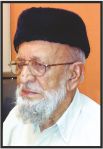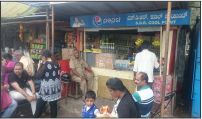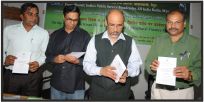Mysuru, KARNATAKA :

by Prof. M.I.K. Durrani
Are you the one who has written the article about the Khans of Kodagu in Star of Mysore,” asked the stranger in a brusque manner as he suddenly made his appearance at the threshold of my office room as I was engrossed in checking the accounts, as the then ‘muthavalli’ (Manager) of Omer Khan Mosque.
“Yes,” I responded meekly, “but I am sure there wasn’t anything libellous or damaging in them! By the by, are you from the Police Department or from the Court with summons?”
“Oh no! Nothing of the sort; but excuse me, I will be back in two minutes,” said the intruder and made his exit as abruptly as he had made his entry. I was a bit flummoxed by the incident since never before had I been accosted by anyone in such a rude way. However, I reverted to my work on hand being sure that the two minutes would be having thousands of seconds in them and there wasn’t much apprehension of the likely re-appearance of the said apparition in the immediate future.
But I was thoroughly mistaken for the man with the lean and hungry look did return within two minutes as he had promised. I have always been a great respecter of punctuality, which is generally a very rare commodity among most of our people. I was on the verge of complimenting him in this regard when I noticed that, even before I could ask him to take the chair, he had just then made himself comfortable in the only other chair that was there, perhaps to have a cosy chat.
This time he had in his hand a large paper bag, obviously fetched from his vehicle parked outside. He inserted his hand into the bag and produced a series of photos of different sizes showing mostly men of an earlier era dressed up in anachronistic ensembles. He said that they were the pictures of his dad, grand-dad and great-grand-dad, who had descended from some migrants hailing from Afghanistan and that they had settled down in a small town of Kodagu.
I asked him what I was supposed to do with those pictures. He said, “I am coming to that. But look at this boy seated on the ground in front of his father. Isn’t he cute?”
“Yes,” I replied, “I think so.”
The visitor continued, “Can you guess who it could be?”
I said I was at sea.
“Oh Sir! Don’t you notice the resemblance?” he continued, “It’s me, and you see I still carry the remains of those captivating looks.” He was getting on my nerves and almost boring me to death.
“Alright, alright,” said I, mustering up all possible patience, “Come to the point, tell me what brought you here?”
“Yes Sir, yes Sir,” he answered, “I am about to broach the subject. I know it will be a child’s play for you. But I have come to ask you to do me a favour. I am sure you will oblige me.”
“Well, what is it?” I enquired.
“My dear Sir,” said the visitor, “My humble request to you is to write an article about my ancestors just as you have done in the case of the Khans.”
I didn’t wish to hurt him by summarily dismissing him; therefore I asked him to enumerate the achievements of his fore-fathers. He said that their paterfamilias had come to Coorg with almost nothing but by sheer hard work, initially as a labourer, had gradually become a coffee planter and bequeathed his vast property to his children who have multiplied into almost a clan.
But I told him that adding to the population by itself can’t be considered something to be exultant about. I asked him just to tell me whether their family as a whole had done anything worthwhile to be proud of. Had they been social workers and whether they had rendered service for the betterment of the community or had they been philanthropic and founded educational institutions and orphanages? Were they given an award in recognition of their meritorious services to humanity?
He replied that they hadn’t done any such thing but they just waited for the opportune time for such activities but unfortunately it didn’t present itself. But they waited, Sir, and you know that “they also serve who stand and wait.”
I said “I am sorry, it isn’t possible for me to write about people who never attempted or achieved anything for the greater good of the people at large.” And that’s that.
Then all of a sudden a thought seemed to have flashed through the mind of the visitor and he confided in me something remarkable concerning himself. He said that out of modesty he had not referred to his own great service to the community but the fact of the matter was that he was instrumental in bringing much happiness to many a family. He further elaborated that he was responsible for several marriages not only in the city of Mysuru but also in the neighbouring districts.
My curiosity was roused and I enquired whether he was a Khazi (Muslim Cleric). “No, no,” he replied, “I have been a match-maker and I have been responsible for several matrimonial alliances. People have great regard for me and always address me as Hazrath, Moulvi Saheb or Moulana, all terms of great reverence. I am also known as Haji though I have not preformed any Haj (Pilgrimage to Mecca). I take pride in this avocation of mine for which I am rewarded not only here, in this life but also hope to be appreciated in the hereafter for preventing men and women from living in sin.”
I appreciated him for his noble thoughts and still nobler profession but expressed my own fears about the immediate future of his profession since it appeared to me to be bleak. I felt that the need for a regular match-maker for the present day smart phone-savvy youths is redundant. Most of the present generation abhor the very idea of a third person’s intervention in the affairs of the heart.
They opine that where two is company, why should it get crowded by the presence of a third party? They make their own selection in such an irrevocable way that their doting parents are left with no alternative but to concede to their choice. And with the passing of time, the practice of arranged marriages will be a thing of antiquity and match-makers will be obsolescent.
Like a sensible man he concurred with me with regard to the bleak future staring in his face. Taking me into his confidence he confessed, “Sir, our business is steadily dwindling and that day doesn’t seem to be far off when we will have to shut up shop. Furthermore, there is too much of occupational hazard these days. Quite often in our job the first casualty is truth and when it is found out we become easy targets. So I have decided to quit and to go in search of pastures new.”
The meeting was becoming quite absorbing. I asked him what other occupation he was contemplating.
“Sir,” he replied, “the first thing I am going to do right now is to discard my outdated mobile phone and will immediately go in for the latest smart phone. Then all the vistas will be before my very eyes — vistas of a bright future that will be blinding in its promised magnificence.”
“And pray what would that be?” I enquired with rousing curiosity.
“You know Sir,” he continued, “the latest smart phone is equipped with all sorts of widgets like chatting, messaging, email, Bluetooth, Facebook, imo, WhatsApp and what not. With all these handy miracles at my finger-tips, don’t you think that I stand a good chance of enticing an heiress or a dowager’s heart?”
“What! Are you still unmarried?” I enquired.
“Yes Sir,” he replied, “I was all the while too busy finding life-partners for others but now time has arrived for me to say goodbye to my bachelorhood.”
He stood up and put all the photos in his paper bag. Then he came closer and catching my hand he kissed it reverentially. He thanked me for giving the indispensable inspiration. He was really overwhelmed, so overwhelmed that he hugged me and then exclaimed, “Thank You, Thank You and Thank You again.” And then he parted from me with sweet sorrow writ large on his face. And I felt happy, very happy for I had done my good deed for the day.
source: http://www.starofmysore.com / Star of Mysore / Home> Feature Articles / February 21st, 2016















